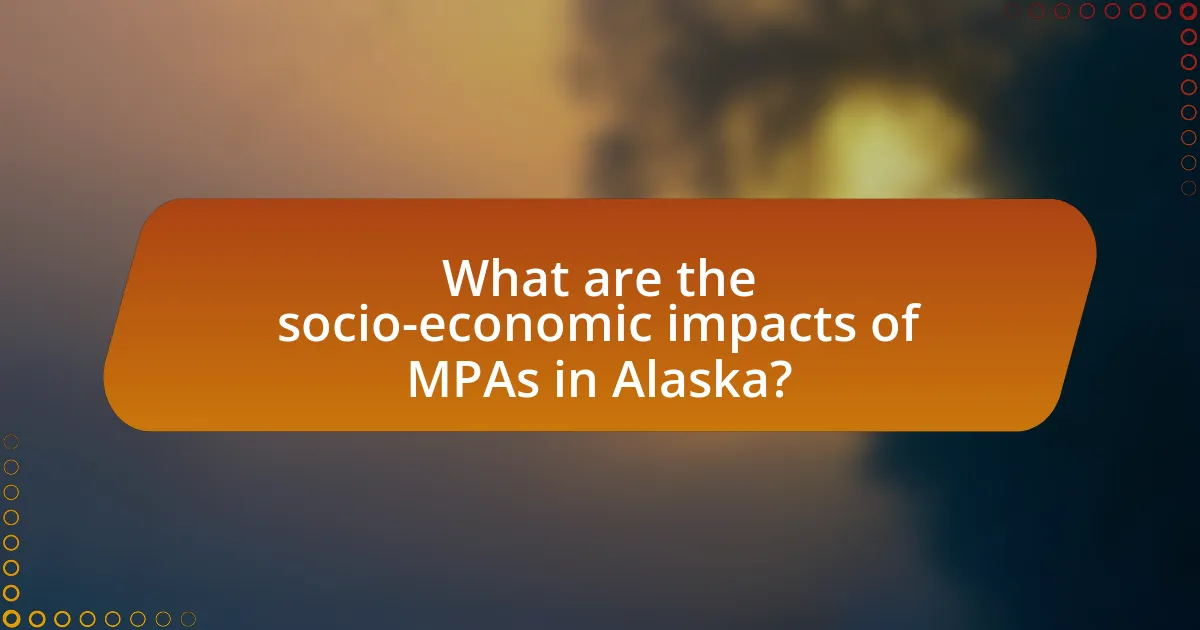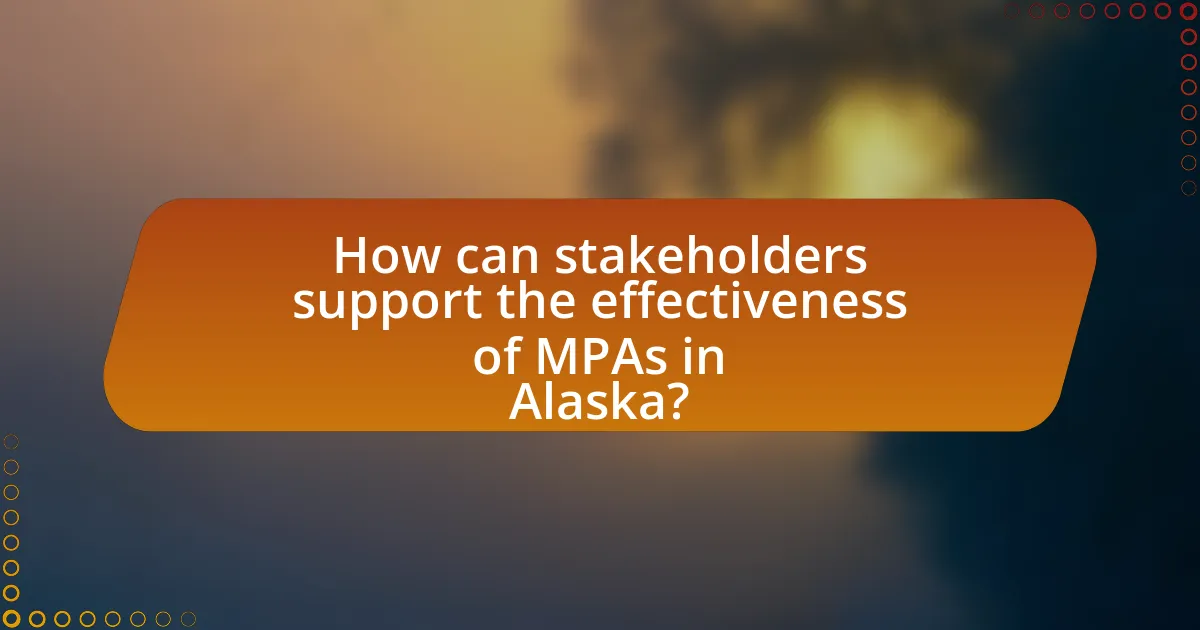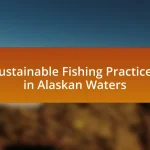Marine Protected Areas (MPAs) in Alaska are designated regions aimed at conserving marine biodiversity and protecting critical ecosystems by regulating human activities. Covering over 3.8 million square miles, Alaska’s MPAs play a vital role in safeguarding habitats essential for fish populations and marine life, enhancing resilience against climate change, and supporting sustainable fisheries. The article explores the functions of MPAs within Alaska’s marine ecosystems, their contributions to biodiversity, the socio-economic impacts on local communities, and the challenges they face, including climate change and regulatory complexities. Additionally, it highlights the importance of stakeholder involvement and adaptive management strategies for the effective governance of these protected areas.
-in-Alaska-1.webp)
What are Marine Protected Areas (MPAs) in Alaska?
Marine Protected Areas (MPAs) in Alaska are designated regions in marine environments where human activities are regulated to conserve biodiversity and protect ecosystems. These areas aim to safeguard critical habitats, such as spawning grounds and nursery areas, which are essential for the sustainability of fish populations and marine life. According to the National Oceanic and Atmospheric Administration (NOAA), Alaska has over 40 MPAs, which cover approximately 3.8 million square miles of ocean, making it one of the largest networks of MPAs in the United States. The establishment of these MPAs is crucial for maintaining the health of marine ecosystems, supporting fisheries, and enhancing resilience against climate change impacts.
How do MPAs function within Alaska’s marine ecosystems?
Marine Protected Areas (MPAs) function within Alaska’s marine ecosystems by providing designated regions where human activities are regulated or restricted to conserve marine biodiversity and habitats. These areas help protect critical habitats such as spawning grounds and nursery areas for various fish species, which are essential for maintaining healthy fish populations. For instance, the establishment of MPAs in Alaska has been shown to enhance the resilience of ecosystems against climate change and overfishing, as evidenced by studies indicating increased biomass and diversity in protected areas compared to unprotected regions. Additionally, MPAs support sustainable fisheries by ensuring that fish stocks can replenish, thereby benefiting both the environment and local economies reliant on fishing.
What types of habitats are included in Alaska’s MPAs?
Alaska’s Marine Protected Areas (MPAs) include a variety of habitats such as coastal wetlands, estuaries, rocky intertidal zones, kelp forests, and deep-sea environments. These habitats are crucial for supporting diverse marine life, including fish, marine mammals, and seabirds. The inclusion of these specific habitats in MPAs is essential for conservation efforts, as they provide critical breeding, feeding, and nursery grounds for numerous species, thereby enhancing biodiversity and ecosystem resilience.
How do MPAs contribute to biodiversity in Alaska?
Marine Protected Areas (MPAs) contribute to biodiversity in Alaska by providing critical habitats that support diverse marine species and ecosystems. These designated areas help to conserve essential habitats such as coral reefs, kelp forests, and estuaries, which are vital for the life cycles of various marine organisms. Research indicates that MPAs can lead to increased species richness and abundance; for example, studies have shown that fish populations within MPAs can be up to 200% larger than those in unprotected areas. Additionally, MPAs help mitigate the impacts of overfishing and habitat degradation, allowing ecosystems to recover and thrive, thereby enhancing overall biodiversity in Alaska’s marine environments.
Why are MPAs essential for conservation in Alaska?
Marine Protected Areas (MPAs) are essential for conservation in Alaska because they safeguard critical habitats and biodiversity in a region that is highly vulnerable to climate change and human activities. MPAs help to preserve the unique marine ecosystems, such as coral reefs and kelp forests, which are vital for the survival of numerous species, including commercially important fish and marine mammals. According to the National Oceanic and Atmospheric Administration (NOAA), Alaska’s MPAs cover over 3 million square miles, providing a refuge for marine life and supporting sustainable fisheries. This protection is crucial as it allows ecosystems to recover from overfishing and habitat degradation, ensuring the long-term health of marine resources that local communities depend on.
What role do MPAs play in protecting endangered species?
Marine Protected Areas (MPAs) play a crucial role in protecting endangered species by providing safe habitats that limit human activities such as fishing, pollution, and habitat destruction. These designated areas help to conserve biodiversity and promote the recovery of vulnerable species by allowing ecosystems to function naturally and regenerate. For example, studies have shown that MPAs can lead to increased populations of endangered species like the Steller sea lion and the humpback whale in Alaskan waters, where specific protections have been implemented. By reducing stressors and enhancing habitat quality, MPAs contribute significantly to the survival and recovery of endangered marine species.
How do MPAs help in the recovery of overfished populations?
Marine Protected Areas (MPAs) facilitate the recovery of overfished populations by providing a refuge where fishing is restricted or prohibited, allowing fish stocks to replenish. Research indicates that MPAs can lead to increased biomass and diversity of marine species within their boundaries, as seen in studies conducted in various regions, including Alaska. For instance, a study published in the journal “Ecological Applications” found that MPAs in Alaska resulted in a 30% increase in fish populations over a five-year period, demonstrating their effectiveness in promoting recovery. By reducing fishing pressure, MPAs enable the natural regeneration of overfished species, contributing to healthier marine ecosystems.

What are the socio-economic impacts of MPAs in Alaska?
Marine Protected Areas (MPAs) in Alaska have significant socio-economic impacts, primarily by supporting sustainable fisheries and enhancing local economies. MPAs contribute to the conservation of marine biodiversity, which in turn helps maintain fish populations that are crucial for commercial and subsistence fishing. For instance, studies indicate that MPAs can lead to increased fish biomass and diversity, benefiting local fishermen and communities reliant on these resources. Additionally, MPAs promote eco-tourism, attracting visitors for activities like whale watching and diving, which generates revenue and job opportunities in coastal communities. The establishment of MPAs has been shown to create a balance between conservation efforts and economic activities, ensuring long-term sustainability of marine resources while supporting the livelihoods of Alaskan residents.
How do MPAs affect local fishing communities?
Marine Protected Areas (MPAs) can significantly impact local fishing communities by restricting access to certain fishing grounds, which may lead to reduced catch for fishermen. These restrictions are intended to conserve marine biodiversity and replenish fish stocks, ultimately benefiting the ecosystem. For instance, studies have shown that MPAs can lead to increased fish populations and sizes within their boundaries, which can enhance fishing opportunities outside the protected areas over time. Research conducted by the National Oceanic and Atmospheric Administration (NOAA) indicates that well-managed MPAs can result in a 20-30% increase in fish biomass, benefiting local fisheries in the long run. However, the immediate effect often includes economic challenges for fishermen who rely on those restricted areas for their livelihoods.
What are the economic benefits of sustainable fishing practices supported by MPAs?
Sustainable fishing practices supported by Marine Protected Areas (MPAs) provide significant economic benefits, including increased fish stocks, enhanced biodiversity, and improved ecosystem health. These benefits lead to higher yields for fisheries, which can result in increased revenue for local fishing communities. For instance, studies have shown that MPAs can lead to a 20-30% increase in fish biomass, which directly correlates with greater catch rates for fishermen operating in adjacent areas. Additionally, sustainable practices help maintain the long-term viability of fish populations, ensuring consistent income for future generations. The economic stability provided by sustainable fishing also supports related sectors, such as tourism and local businesses, contributing to overall community resilience.
How do MPAs influence tourism in Alaska?
Marine Protected Areas (MPAs) significantly influence tourism in Alaska by enhancing the ecological health of marine environments, which attracts visitors seeking natural beauty and wildlife experiences. The establishment of MPAs helps to preserve biodiversity, leading to increased populations of marine species such as whales, seals, and fish, which are key attractions for tourists. For instance, the Kenai Fjords National Park, part of an MPA, reported over 300,000 visitors in 2019, drawn by its rich marine life and stunning landscapes. Additionally, MPAs contribute to sustainable tourism practices, ensuring that natural resources are available for future generations while providing economic benefits to local communities through eco-tourism initiatives.
What challenges do MPAs face in Alaska?
Marine Protected Areas (MPAs) in Alaska face significant challenges, including climate change, overfishing, and regulatory complexities. Climate change leads to shifting marine ecosystems, affecting species distribution and habitat integrity, which complicates conservation efforts. Overfishing threatens the sustainability of fish populations, undermining the goals of MPAs to protect marine biodiversity. Additionally, regulatory complexities arise from overlapping jurisdictions among federal, state, and local authorities, making effective management and enforcement of MPAs difficult. These challenges hinder the effectiveness of MPAs in preserving Alaska’s marine resources and ecosystems.
How do climate change and pollution threaten Alaska’s MPAs?
Climate change and pollution threaten Alaska’s Marine Protected Areas (MPAs) by altering ecosystems and degrading water quality. Rising temperatures lead to habitat loss, such as the melting of sea ice, which is crucial for species like polar bears and seals. Additionally, increased ocean acidification, a direct result of climate change, negatively impacts marine life, particularly shellfish and coral reefs. Pollution from land runoff and maritime activities introduces harmful substances into these protected areas, further compromising biodiversity and ecosystem health. Studies indicate that over 50% of Alaska’s coastal waters are affected by pollution, which exacerbates the vulnerabilities of MPAs.
What are the management challenges associated with enforcing MPAs?
The management challenges associated with enforcing Marine Protected Areas (MPAs) include insufficient funding, lack of enforcement personnel, and conflicting stakeholder interests. Insufficient funding limits the resources available for monitoring and enforcement activities, which are crucial for the effective management of MPAs. A study by the National Oceanic and Atmospheric Administration (NOAA) highlights that many MPAs operate with minimal budgets, hindering their ability to conduct regular patrols and surveillance. Additionally, the lack of enforcement personnel results in inadequate oversight, allowing illegal activities such as poaching and habitat destruction to occur unchecked. Conflicting stakeholder interests, such as those between commercial fishers and conservationists, complicate enforcement efforts, as differing priorities can lead to resistance against regulations designed to protect marine ecosystems. These challenges collectively undermine the effectiveness of MPAs in achieving their conservation goals.

How can stakeholders support the effectiveness of MPAs in Alaska?
Stakeholders can support the effectiveness of Marine Protected Areas (MPAs) in Alaska by actively participating in management decisions and conservation efforts. Engaging in collaborative governance allows stakeholders, including local communities, fishermen, and conservation organizations, to contribute valuable local knowledge and ensure that management strategies align with ecological and socio-economic needs. Research indicates that stakeholder involvement leads to more effective conservation outcomes, as seen in the success of the Alaska Marine Conservation Council’s initiatives, which emphasize community engagement and sustainable practices. By fostering partnerships and sharing resources, stakeholders enhance the resilience and ecological integrity of MPAs, ultimately benefiting both marine ecosystems and local livelihoods.
What role do local communities play in MPA management?
Local communities play a crucial role in Marine Protected Area (MPA) management by contributing local knowledge, participating in decision-making processes, and ensuring sustainable practices. Their involvement enhances the effectiveness of MPAs, as local residents often possess valuable insights into the ecological and cultural significance of marine resources. Studies have shown that community engagement leads to better compliance with regulations and increased stewardship of marine environments, as evidenced by successful MPA initiatives in Alaska where local input has resulted in tailored management strategies that reflect both ecological needs and community values.
How can education and outreach enhance community involvement in MPAs?
Education and outreach enhance community involvement in Marine Protected Areas (MPAs) by increasing awareness and understanding of marine ecosystems and conservation efforts. When communities are educated about the ecological and economic benefits of MPAs, such as improved fish stocks and biodiversity, they are more likely to participate in conservation activities. For instance, studies have shown that community-led initiatives in Alaska, supported by educational programs, lead to higher compliance with fishing regulations and increased stewardship of marine resources. This engagement is crucial for the long-term success of MPAs, as informed communities can advocate for sustainable practices and contribute to monitoring and protecting marine environments.
What best practices can be implemented for effective MPA governance?
Effective Marine Protected Area (MPA) governance can be achieved through stakeholder engagement, adaptive management, and scientific research integration. Stakeholder engagement ensures that local communities, indigenous groups, and other relevant parties are involved in decision-making processes, which enhances compliance and support for conservation efforts. Adaptive management allows for the continuous assessment and adjustment of management strategies based on ecological and social feedback, ensuring that governance remains effective in changing conditions. Integrating scientific research into governance frameworks provides a solid evidence base for decision-making, enabling the implementation of best practices that are informed by the latest ecological data and trends. These practices are supported by studies indicating that inclusive governance leads to better conservation outcomes and resilience in marine ecosystems.
What are the future prospects for MPAs in Alaska?
The future prospects for Marine Protected Areas (MPAs) in Alaska are promising, driven by increasing recognition of their ecological and economic benefits. As of 2023, Alaska has designated over 3.8 million square miles of ocean as MPAs, which play a crucial role in conserving marine biodiversity and supporting sustainable fisheries. The ongoing efforts by state and federal agencies, alongside local communities, aim to enhance the management and expansion of these areas, particularly in response to climate change impacts. Research indicates that well-managed MPAs can lead to increased fish populations and healthier ecosystems, which are vital for the livelihoods of coastal communities. The integration of traditional ecological knowledge with scientific research further strengthens the effectiveness of MPAs in Alaska, ensuring they meet both conservation goals and community needs.
How can adaptive management strategies improve MPA outcomes?
Adaptive management strategies can improve Marine Protected Area (MPA) outcomes by enabling continuous learning and adjustment based on ecological feedback. These strategies involve monitoring ecological conditions, assessing the effectiveness of management actions, and making informed changes to management practices as necessary. For instance, a study published in the journal “Conservation Biology” by Allen et al. (2011) demonstrated that adaptive management in MPAs led to improved fish populations and biodiversity by allowing managers to respond to changing environmental conditions and stakeholder needs. This iterative process enhances the resilience of marine ecosystems, ultimately leading to more effective conservation outcomes in Alaska’s MPAs.
What innovations in technology can aid in MPA monitoring and enforcement?
Innovations in technology that can aid in Marine Protected Area (MPA) monitoring and enforcement include satellite imagery, drone surveillance, and underwater acoustic monitoring. Satellite imagery provides real-time data on environmental changes and illegal activities, enabling timely interventions. For instance, the European Space Agency’s Sentinel satellites offer high-resolution images that can detect illegal fishing activities in MPAs. Drone surveillance enhances monitoring capabilities by allowing for aerial inspections of remote areas, significantly reducing the time and cost associated with traditional patrols. Additionally, underwater acoustic monitoring systems can track marine life and detect illegal fishing gear, providing critical data for enforcement efforts. These technologies collectively improve the effectiveness of MPA management and compliance.
What practical steps can individuals take to support MPAs in Alaska?
Individuals can support Marine Protected Areas (MPAs) in Alaska by participating in local conservation efforts, advocating for policy changes, and engaging in responsible recreational activities. Joining organizations focused on marine conservation, such as the Alaska Marine Conservation Council, allows individuals to contribute to initiatives that protect marine ecosystems. Advocating for policies that strengthen MPA regulations can influence decision-makers to prioritize marine conservation. Additionally, practicing sustainable fishing, boating, and wildlife viewing helps minimize human impact on these protected areas, ensuring their health and longevity. These actions collectively contribute to the preservation of Alaska’s unique marine environments.


